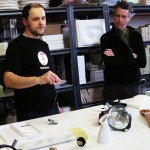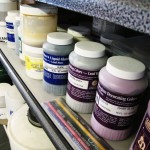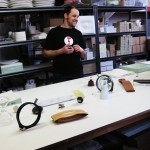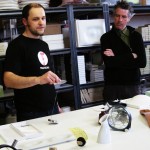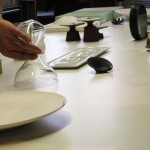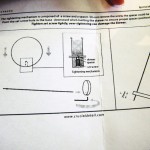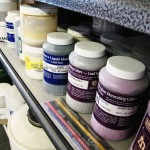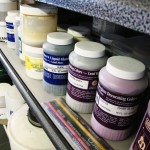
For my second Fête event this weekend, I had the rare chance to tour the Crucial Detail studio, led by designer Martin Kastner. He’s best known for designing breathtaking servingware for chef Grant Achatz’s Alinea, Next, and Aviary. His beautiful vessels are meant to translate Achatz’s innovative cooking techniques into each dish’s aesthetic presentation on the table. In a discussion moderated by Columbia College professor Kevin Henry, Kastner discussed how his work lands at an intersection of food and design.
Kastner grew up in the Czech Republic and started a career as a castle blacksmith. After marrying an American and relocating to her home country, however, he realized he was essentially unemployable (not too many castles here). It was then that he first explored design, wanting to be more personally expressive rather than retracing the creative steps of others. He also ended up helping his wife at a bakery many mornings and was intrigued by dough as a material, which planted a seed in his mind to think more critically about food.
In the late ’90s, Kastner received an email inquiry from Achatz completely out of the blue. Achatz had found Kastner in a web search for designers in the Midwest, which only returned a few dozen sites at the time. Kastner’s first project for Achatz was the Tripod, designed to serve an ice sphere that stood up on three legs when placed on the table, then collapsed into a lollipop-style stick when the diner picked it up. From there, the rest is history. Kastner went on to tell some of the stories behind his designs, many of which I’ve been fortunate enough to experience at Alinea and Aviary.
For example, the Porthole. It’s in use at Aviary and is likely Kastner’s most famous design due to a recent Kickstarter campaign that hit 10,000 orders within its first week. It was designed for a time-based cocktail that infuses ingredients over a longer period, so that with each pour, the drinker should be able to taste and see the difference in the drink. “The goal is to drive behavior,” Kastner said, so that the intended drinking process would be clear enough to the customer to not need further guidance. Interestingly, when the Aviary team first conceived this slow-infused cocktail, they originally envisioned serving it in a teapot, but Kastner suggested that it would be much more effective to have it visible through a sort of window, and to somehow enclose the drink in a marine environment (like a porthole). The vessel got a huge response, and I can attest that it’s a gorgeous, dramatic presentation, as seen in the close-up above.
Also in use at Aviary are trios of Petals (seen at right above). They were designed to serve small bites in multiples, but still leave as small a footprint on the table as possible. They also needed to have the ability to preheat and pre-chill the vessels, since as Kastner put it, “food is a time-based medium.” When I saw the plates hit the table at Aviary, I noticed that they were elegant and multi-leveled, but never considered the amount of space they took up on the table, or their differing temperatures. While I’m sure that lack of awareness was exactly the point – for the experience to be seamless and the focus to remain on the food – it makes it that much more meaningful to know what’s really behind these designs.
Kastner delved into the story of the Antenna as well, which I immediately remembered from my meal at Alinea. The idea came from Kastner’s frustration with the inefficiency and clumsiness of bites being presented on a skewer, but then having a knife and fork alongside the plate too. His solution was this single, streamlined, provocative utensil. “When that lands on the table, people stop talking,” Kastner said. It’s dynamic, since it moves around in the air, and the chef can play with textures, flavors, and sound in a unified way. Most fascinating to me, though, was his explanation that it also allows the chef to have precise control over which part of the dish hits each area of the mouth. Pretty awesome.
“I never expected to be in this culinary freak show that I’m in,” Kastner admitted, laughing, but embraces it as a specialty in which he’s found great success. Kastner stressed that it’s the satisfaction of finding the right solution, both in form and in function, that really keeps him motivated.


The details: View more Crucial Detail designs, and the full Fête event schedule.
